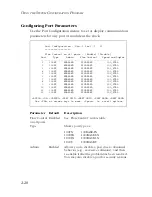
U
SING
THE
S
YSTEM
C
ONFIGURATION
P
ROGRAM
2-42
Configuring Port Trunks
Port trunks can be used to increase the bandwidth of a network
connection or to ensure fault recovery. You can configure up five
trunk connections (combining 2~4 ports into a fat pipe) between
any two standalone SMC6924VF switches, or up to 12 for an entire
stack. However, before making any physical connections between
devices, use the Trunk Configuration menu to specify the trunk on
the devices at both ends. When using a port trunk, note that:
•
The ports used in a trunk must all be of the same media type
(VF-45, 100 Mbps fiber, or 1000 Mbps fiber). The ports that can
be assigned to the same trunk have certain other restrictions as
described on page 2-44.
•
Ports can only be assigned to one trunk.
•
The ports at both ends of a connection must be configured as
trunk ports.
•
The ports at both ends of a trunk must be configured in an
identical manner, including speed, duplex mode, and VLAN
assignments.
•
None of the ports in a trunk can be configured as a mirror
source port or mirror target port.
•
All the ports in a trunk have to be treated as a whole when
moved from/to, added or deleted from a VLAN.
•
The Spanning Tree Algorithm will treat all the ports in a trunk
as a whole.
•
Enable the trunk prior to connecting any cable between the
switches to avoid creating a loop.
•
Disconnect all trunk port cables or disable the trunk ports
before removing a port trunk to avoid creating a loop.
Содержание TigerSwitch 100 SMC6924VF
Страница 2: ......
Страница 12: ...TABLE OF CONTENTS vi ...
Страница 156: ...ADVANCED TOPICS 4 12 ...
Страница 160: ...TROUBLESHOOTING A 4 ...
Страница 164: ...PIN ASSIGNMENTS B 4 ...
Страница 172: ...INDEX Index 4 ...
Страница 173: ......
















































